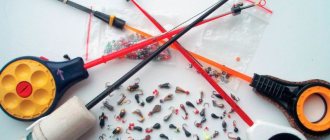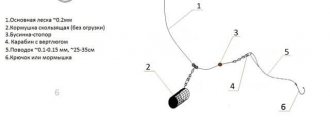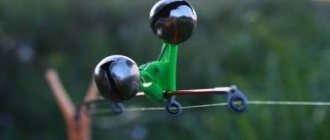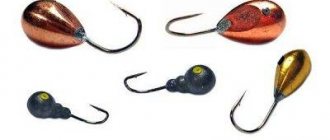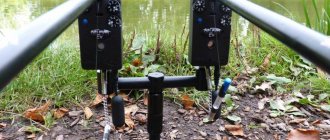Over the entire existence of winter fishing, people have come up with many devices that make this exciting activity easier. A bite alarm for winter fishing is one of the mandatory components of fishing equipment at this time of year.
Actually, the very first bite alarm on any fishing trip was an ordinary float. It is also present in today’s winter fishing rods, but nowadays, signaling devices come from a wide variety of devices, including electric ones. Moreover, almost every year new models are invented. We will talk about some of them today.
What it is?
A bite alarm for a winter fishing rod is a device that shows the fisherman that a fish has taken the bait. This gear is designed to perform 2 tasks:
- if an angler sits directly at the hole and fishes with one fishing rod, the alarm, which, in most cases, is a sensitive nod, indicates the slightest approach of fish, which is usually inactive in cold winter water;
- if fishing takes place with several fishing rods at once in different openings, the alarm speaks not so much about a bite, but about hooking; not only movable types of this gear are used here, but also light and even sound.
Some fishermen use winter fishing rods simply with a whip, avoiding nods or guards, as they are also called, but this happens rarely, usually when trolling vertically and catching large predatory fish.
Bite alarm for a winter fishing rod, how to choose a winter alarm
A bite alarm is a very popular device in winter, especially for anglers who spend several days fishing. Electronic devices are considered one of the most popular alarm models in winter.
The winter bite alarm is an electronic type, has a key fob design that reacts to sensor strikes. The alarms have a Bluetooth function that transmits an alert at a distance of 20 to 50 meters, so the angler can be in a warm tent or in a car, as well as at another fishing spot.
The design of the electronic signaling device is fixed to the vent; to select the sensitivity of the signal, simply move the device lower or higher along the form.
As soon as a bite occurs, an alert is transmitted via the Bluetooth channel, and you can start catching fish. Another important point of such an alarm is to track not only the bite, but also the theft of the trophy, if someone wants to steal the gear.
Anglers use electronic alarms when fishing for pike when they need to wait a long time for a bite; at this time, they can set up several more rods for other holes.
Also in winter, nod signaling devices are used, they need to be constantly monitored, and the nod material you need to choose is one that is adapted to frost, since a plastic nod in the cold season can become deformed during fishing and there will be no bite.
Types of bite alarms
Mechanical
These include:
- float - usually it is much smaller in size than the summer one, and it is slightly sunk into the ice hole so that it does not freeze;
- nod or guard - a sensitive piece of equipment that is attached to a whip, it is made of lavsan, springs, silicone and even boar hair, there are many options;
- Shcherbakov’s nod is especially highlighted ; we’ll talk about this original tackle later.
Basic requirements for such gear: sensitivity, resistance to wind and frost, strength.
Electrical
This gear runs on batteries or special batteries, and this type of electronic alarms is also divided into types:
- sound - when the fishing line is pulled, simply put, the contacts close and a certain signal sound is heard, such alarms are very convenient if the holes are made at some distance from each other;
- light - such alarms are convenient in the dark; they are LED and use chemical reagents; in the latter version, when the fishing line is pulled, a special capsule with reagents is broken, which, when mixed, give the effect of light;
- using a pager - when there is a bite, the signal is transmitted to the pager, which is located on the fisherman, wherever he is.
There are also combined options that can use several types at once.
Types of alarms
All devices that monitor the bite on a donk or fishing rod are divided into audio and visual. Some mechanical devices and modern electronic alarms can combine both notification methods.
Let's try to systematize bite indicators by their design, by how they work, by the type of alert, by their location on the bottom tackle and other features:
- Pendulums.
- Nods.
- Bells.
- Fireflies.
- Electronic devices.
Let's look at each of them in detail.
Pendulums
The essence of all models of pendulum indicators comes down to monitoring the mechanical displacement of any structural element. The simplest pendulum is a twig or piece of clay hung on a donkey line.
Modern bite alarms of this type are simple devices that consist of a tube with two rings at the ends. Their choice is quite wide thanks to the products of our Chinese comrades presented on the modern fishing market, but they are not difficult to make yourself.
Homemade pendulum signaling device
Here are brief instructions on how to make a regular bite alarm with your own hands:
- We take a soft wire 30 centimeters long. The choice of elastic wire is also possible, but it will be more difficult to make a pendulum and use it.
- At one end we fold a loop with a diameter of about a centimeter.
- We put a plastic tube 10-15 centimeters long on the rod with a loop. In this case, the bent end of the wire should enter the tube by about one centimeter.
- We put some light, bright body on our rod. This could be the body from an old float, a capsule from a chocolate egg (you can also put a couple of peas in it for sound) or something similar.
- Next, we put a short one or two centimeter piece of tube onto the wire.
- We bend the loop at the end of the wire so that its plane is perpendicular to the first loop, and the cut end fits one centimeter into the small tube.
- We fasten the first loop in the rod ring, and pass the fishing line through the second.
This design works very simply. After casting, we tighten the line so that the pendulum takes a position of forty-five degrees relative to the blank. Now, when pulled, it will rise, and when loosened, it will fall.
Such alarms are also called “swingers,” although in fact a swinger is a plumb line, which is used mainly in conjunction with an audible alarm and looks like a weight that is attached to a fishing rod stand on a chain or metal rod.
The swinger is put on the fishing line through balls brought together at the top, which release the fishing line when hooked. Such devices are produced, for example, by . Some of them are equipped with a mini-electronic device with batteries and LEDs for visualizing the bite in the dark.
Nods
Nods are used for winter fishing and for equipping a light summer fishing rod for jig fishing. This tackle is called: “side nod”.
Winter fishing rods for the most part (except for float rods or girders) are equipped with nods. Moreover, a good half of fishermen prefer to use a homemade bite alarm - a nod made using their own technology.
A side bite alarm for a summer fishing rod is also easy to make yourself. Here is the sequence of making this gear:
- We attach a piece of soft tube to the end of the fishing rod with tape or tape; we will need it to mount the nod itself.
- We fix a soft but elastic wire at one end in a prepared tube. To make the wire hold better, you may need to bend it in half or three times.
- We bend the wire at an angle of ninety degrees to the rod.
- We place a bright element on the end of the wire, which will be clearly visible during the fishing process.
- At the end of the wire we make a loop for passing the fishing line.
Another option often used for donkeying is attaching a nod to the rod blank between the reel and the first ring. In both cases, in fishing parlance, this side bite signal is called a “side nod.”
Bells
In this category we have included a variety of sound devices that help in fishing. This type of indication is used on bottoms in the dark or when there is a significant amount of bottom fishing gear that is not visible. Among other things, sound alarms are the only choice of our visually impaired fellow hobbyists.
Sound indicators are:
- small classic bells, they have long been equipped with bottom gear, including those with a rubber shock absorber;
- bells-eggs on a clothespin, produced in abundance by the Chinese;
- rattles, including homemade ones.
fireflies
We have combined a wide variety of light indicators for fishing in the dark into this category. A bite alarm for night fishing with a feeder or bottom tackle has evolved from a bright piece of paper that gives reflections in the light of a fire to modern electronic and chemical models.
In addition to the fact that light indicators are included in many electronic devices, they are also produced separately. Light bite alarms can be chemical, electrical or light accumulative.
- Chemical fireflies. Such alarms operate from a chemical reaction that emits a glow when two compounds are mixed. These compounds are enclosed in a plastic ampoule, when broken, a reaction occurs that causes a glow.
- Electrical alarms are indicators powered by a miniature battery. Also, an electric bite alarm for a feeder can have two indicators: green lights up during the entire fishing process, orange lights up when a bite occurs. This feature distinguishes the “Strike alert” model.
- Light-accumulating indicators work due to their glow after a short period of illumination with bright light. It is necessary to carry a powerful electric flashlight along with such alarms.
Electronic devices
Electronic alarms for bottom gear are currently available for any choice. Fishing with them, in addition to luck, brings into the process a share of technological progress and a sense of personal “advancement” in the soul of the fisherman. The operating principle of such devices is based on the passage of fishing line between the contacts or on the vibration of the rod blank. Moreover, bite signals can be given by sound, light, or transmitted via radio waves to a pager.
It is not advisable to use a pager as a feeder bite signal, because when feeder fishing, the choice of indication is obvious - quivertip (sensitive tip). These devices are used by carp anglers who, after feeding the point and casting the tackle, rest in tents, waiting for a bite.
The simplest electronic bite alarm for a feeder is a small device that is mounted on the rod blank. A fishing line is passed through its contacts and when it moves, a sound signal is heard.
At the next level there are indicators that are mounted on a rod pod or rod stand. The principle of their operation is also based on the length of the fishing line between the contacts. Modern fishing stores can offer a whole set of bite alarms in a separate case.
Such gadgets are often used in carp fishing. Each of these devices has its own signal melody and light indication, which helps the fisherman correctly identify the fishing rod on which the bite occurred. To secure a bite to the shore, you need a swinger that pulls the line with its weight.
Separately, we need to talk about a device that works, like the above-mentioned “Strike alert”, due to the vibration of the form. This is the “Electronic bite alarm Megatex”, which is a light and sound device. It attaches easily to the rod and is adjustable to different degrees of sensitivity. And the Soyka-3 model is a truly smart bite alarm. It can also be used on fishing rods for winter fishing due to the miniature size of the device.
Is it possible to do it yourself
Any experienced fisherman will confidently tell you that there is practically no equipment that cannot be made with your own hands at home. The same applies to bite alarms. Some of them are generally simple, some are relatively complex, like Shcherbakov’s nod. But if you buy certain components or even find them in old gear, the result can be quite successful. A homemade alarm can be more effective for the following reasons:
- real handmade work is always better than industrial work;
- sometimes complex store gear of this kind is quite expensive;
- any fishing tackle is adjusted to a specific body of water, weather conditions, and the preferences of the fisherman himself - often store-bought alarms do not fully meet these requirements.
So we will try to consider how and with what materials and tools you can make them yourself.
Step by step instructions
Today there are quite a lot of options for each type. Let's present some options that are not very difficult to manufacture, inexpensive, but at the same time considered catchy.
Protozoa
From a coiled spring
This mechanical model of the guard is considered rigid; it is used mainly for fishing with a balance beam or for large predatory fish at great depths . The process is simple, but requires some experience when choosing the source material:
- Any twisted spring is selected, its length and size depend on the fishing conditions.
- A certain segment of it is cut off.
- A ring is made from wire with a small tolerance.
- On one side it is soldered to the spring.
- It is advisable to leave a small ball in place of the solder.
- On the other side, the small end of the spring is straightened.
- A connector is attached to a whip; it can be made by removing a two-core wire from a small piece of insulation.
- It is advisable to paint the product in a bright color.
You can even catch large pike with such a signaling device if you choose the right rigidity of the gear.
Expert opinion
Knipovich Nikolai Mikhailovich
Zoologist, hydrobiologist. I am interested in fishing at a professional level.
Important! Adjusting the deviation of the spring from its normal state is of great importance. This is achieved by selecting the length and resistance of the starting material itself.
For this reason, you should first take either a very long spring so that you can make several blanks from it at once, or several different ones.
From a clock spring
Any mechanical watch has a spring; it can be easily removed from old ones. Already broken products, of which there are probably a lot in the apartment. The process then looks like this:
- The spring must be aligned.
- A section of 12-15 cm is cut.
- One edge tapers to 2-3 mm.
- A loop is made from wire, as in the previous case, with a diameter equal to the cross-section of the narrowed edge.
- The loop is soldered, as in the previous case.
This type of lodge is well suited for catching perch with a jig .
"Snot"
Here the production is not at all difficult:
- Take a piece of fishing line of medium diameter.
- Wraps on any rod.
- The resulting preparation is boiled in water for several minutes.
- The fishing line is removed from the rod, equipped with cambrics on both sides and attached to the whip.
This guard is highly sensitive and is intended for fishing in still water at shallow depths.
Side
It is made in a unique way:
- A loop for passing the fishing line is soldered to the nod made of a strip of metal approximately in the middle of its length.
- A tulip is soldered onto the thin end of the nod.
- The other end is attached to a connector with a side section, it turns out that the nod is located perpendicular to the whip.
- A loop is attached to the end of the whip for passing the fishing line.
The main beauty of this gear is that such a signaling device can be observed not only from above, sitting above the hole, but also from the side, lying, say, on a mat or in a tent.
Shcherbakov's nod
A very original but sensitive design. True, it is poorly suited for fishing in the current and for vertical trolling when catching a large predator.
The manufacturing process is not entirely simple, so first let’s decide what we need for the job:
- the main part of the structure is a bearing with a diameter of about 3 mm; it can be removed from the hard drive of old computers;
- tulip;
- a piece of wire up to 2 m long;
- intermediate ring;
- winter fishing rod:
- sliding sinker.
Also useful:
- vice;
- screwdriver;
- soldering iron;
- soldering material;
- pliers and wire cutters;
- hacksaw for metal;
- sandpaper.
The most difficult manufacturing stage is the first, when the bearing is wrapped. Further - easier:
- Using a vice and a screwdriver, a loop is made from wire, the diameter of which is slightly larger than the diameter of the bearing.
- In this case, one of the remaining wire mustaches should be slightly longer than the other.
- The mustache is aligned to the same length.
- The loop is soldered to the bearing along the diameter.
- A sinker is installed on the short end of the wire.
- A tulip and a pass ring are attached to the other end.
- The bearing is put on the fishing rod, it turns out that the nod is located across it.
The principle of operation is surprisingly simple: the wire nod with the help of a sinker is adjusted so that at the slightest bite it lifts the sinker from the ice and seems to turn over.
Expert opinion
Knipovich Nikolai Mikhailovich
Zoologist, hydrobiologist. I am interested in fishing at a professional level.
Important! The bearing must be very sensitive and smooth. Therefore, you should immediately stop buying Chinese products, they quickly break down.
If the diameter of the bearing hole is larger than the cross-section of the fishing rod, it can be strengthened using rubber of the appropriate size.
Sound
There are many options, but here is one of the simplest. Let's take the following set:
- microscopic five-volt buzzer;
- a piece of copper wire;
- ordinary nod;
- a lighter with a battery pack for a flashlight;
- heat shrink tubes.
The manufacturing process is simple and, most importantly, does not require large expenses:
- Remove the battery pack from the lighter.
- The buzzer is attached to the contacts of the block.
- A ring is made from wire, its tendrils are attached to the whip using connectors.
- A fishing line is threaded through the ring.
- The ends of the wire are soldered to the buzzer contact.
- During a bite, the contacts close and a sound signal sounds.
If you use not only batteries, but also an LED from a flashlight, which is attached to them in the lighter, you will get a combined light and sound alarm .
Expert opinion
Knipovich Nikolai Mikhailovich
Zoologist, hydrobiologist. I am interested in fishing at a professional level.
Important! If there is no sound from the buzzer when it closes, the polarity of the contacts may need to be reversed.
It is noteworthy that the sound from such a buzzer is much more melodic and pleasant than that produced by Chinese alarms.
Light
We use materials:
- Light-emitting diode;
- coin cell battery;
- heat-shrink tubing;
- two silicone tubes corresponding in diameter to the LED.
Let's start creating the model:
- We insert the battery into the heat-shrink tube and burn it with a lighter to shrink it.
- Place the LED in a silicone tube.
- Isolate it there from water using silicone glue.
- The structure is connected to a whip and fishing line so that when the fishing line closes the contacts with the battery, the LED is activated.

